Ciao I’m Natalia of Gatti Fili e Farina. I’m a textile conservator, wife, mother of two, cat lover, crocheter and on and on but since I was a kid I have always been deeply in love with baking and, obviously, baked treasures!
I must tell you that I started blogging to participate to The Daring Baker’s group, thanks to the help of Enza of da grande who taught me many things about blogging; so it goes without saying how very honored I am to host this challenge ! I really hope you enjoy my choice the recipe I chose is Savarin: a yeasted cake made with the same dough as Rum Baba who has its controversial origins in the Polish Babka. Apparently, in the eighteen century the recipe traveled with the exiled Polish king Stanislas who once soaked a dried Babka in an alcoholic solution creating what is now known as Baba au Rhum. The original Babka (Christian version) is often baked in a tall ring mold but it is in the Julien brothers’ Patisserie in 1844 that it was baked in the classic Savarin mold (who takes its name from the eclectic lawyer, politician and gastronome Jean Anthelme Brillat-Savarin). Years later thanks to an unknown French cook the Baba traveled to Naples were it is still one of the most popular treat: o’ Babbà!
The Savarin ‘hole’ is filled with different creams, or custards and decorated with fruits, candied fruits and so on.
Recipe Source: I must tell you that I tried many recipes (we are submerged in Savarins!) and the recipe I chose is a mix of the recipes from a very famous Italian Blogger, Adriano Continisio of Profumo di Lievito, and a very famous Italian Chef : Luca Montersino. He has his show on Alice TV, a cable channel that focuses on cooking . The link to their recipes are: and. For the pastry cream I followed the recipe in Professional Baking by Wayne Gisslen. For the syrup I followed the recipe from Luca Montersino
Blog-checking lines: Natalia of Gatti Fili e Farina challenges us to make a traditional Savarin, complete with soaking syrup and cream filling! We were to follow the Savarin recipe but were allowed to be creative with the soaking syrup and filling, allowing us to come up with some very delicious cakes!
Posting Date: April 27, 2013
Note: This is a very rich dough but following Luca’s and Adriano’s tips and with the help of a mixer you won’t have any trouble!
The key is to know how to handle a very rich dough.
We need a very healthy and active gluten in this recipe but fats can inhibit it; so we have to develop the gluten well before adding any fat. For this reason I liked the fact that Adriano adds even the yolks after the autolyse not to disturb gluten at all. The salt crystals can cut the elastic strands of the gluten too so they are added later as the butter who is the last addiction.
After the first proofing we proceed in a couple of folds to strengthen the structure of our dough with the ‘Dough Package fold’ method that will result in a smaller and tighter crumb. After that the dough will be shaped on the work bench with a method called “Pirlatura” (that is used for Panettone as well) put in the pan, proofed , baked and then soaked in a flavored syrup. In my recipe I chose to fill the hole with what we, in Italy, call Chantilly that is a pastry cream thinned with whipped cream. And then I decorated it with fresh fruit.
Mandatory Items: You must use this recipe for the Savarin
Variations allowed: You can create your own syrup to soak the Savarin and choose a different filling to put in the ‘hole’ too!
Recipe
Preparation time:
Sponge: 30 minutes
First Mixing and Autolyse: 35 minutes
Second Mixing: 35 minutes
Proofing: 2 to 3 hours
Shaping: 20 minutes
Final Rising: 1 to 1,1/2 hour
Syrup preparation: 15 minutes
Glaze preparation: 10 minutes
Pastry cream preparation: 30 minutes
Whipped cream preparation: 15 minutes
Baking: 40 minutes
Soaking: 1 hour
Glazing: 10 minutes
Equipment required:
• Scale or measuring cups and spoons
• Stand mixer with paddle and beater or hand held mixer with dough hooks and beaters or very motivated arms!
• Dough scraper or spatula
• Grater for lemon and orange zest
• Knife for lemon and orange peel
• Small bowl for the sponge
• Bowl for egg whites
• Bowl for yolks
• Small bowl for butter
• Saucepan for pastry cream
• Bowl for Pastry cream
• Saucepan for syrup
• Saucepan for the glaze
• Brush for the glaze
• 28 cm (11 inches) Savarin mold (springform or not)
• Cling film
• Cooling rack to let the cake drip
• Pan that fits under the cooling rack to catch the drippings
• Ladle
• Big bowl for soaking the Savarin
Servings: 8/10
Ingredients
2½ cups (600 ml) (12-1/3 oz) (350 gm) bread flour
2 tablespoons (30 ml) water, lukewarm
6 (320 gm) large eggs at room temperature, separated
½ satchel (1½ teaspoons) (4 gm) instant yeast or 15 gm (½ oz) fresh yeast
4 teaspoons (20 ml) (20 gm) sugar
2/3 stick (1/3 cup) (80 ml) (75 gm) butter at room temperature
1 tablespoon (15 ml) (15 gm) (½ oz) orange and lemon zest (optional)
1 teaspoon (5 ml) (6 gm) salt
¼ cup (60 ml) (2 oz) (55 gm) butter for greasing the work surface, hands, dough scraper & baking pan
Directions:
Sponge
In a small bowl mix 2 tablespoons (30 ml) lukewarm water, 3 tablespoons (1 oz) (25 gm) flour and yeast , cover with cling film and let rise 60 minutes
Dough
1.After 30 minutes put the egg whites in the mixer bowl and start working with the paddle at low speed adding flour until you have a soft dough that sticks to the bowl (about 2 cups or 270 gm) and work until it comes together , cover with cling film and let rest 30 min
2.Add the sponge to the mixer bowl along with a tablespoon of flour and start mixing at low speed (if you wish to add the zests do it now)
3.When it starts pulling away from the sides of the bowl add one yolk and as soon as the yolk is absorbed add one tablespoon of flour
4.Add the second yolk , the sugar and as soon as the yolk is absorbed add one tablespoon of flour
5.Raise the speed a little
6.Add the third yolk and the salt and as soon as the yolk is absorbed add one tablespoon of flour
7.Keep on adding one yolk at the time and the flour saving a tablespoon of flour for later
8.Mix the dough until is elastic and makes threads
9.Add the butter at room temperature and as soon as the butter is adsorbed add the last tablespoon of flour
10.Keep on mixing till the dough passes the window pane test
11.Cover the dough with cling film and let it proof until it has tripled in volume 2 to 3 hours.
12.You can prepare the Pastry cream now if you chose to use it, and refrigerate it
13.While you wait prepare your baking pan buttering it very carefully not leaving too much butter on it
14.Grease your dough scraper, your hands and your work surface and put the dough on it and fold with the Dough Package Fold two or three times around (5 folds twice or three times). Cover with cling foil and let it rest 15 minutes on the counter
16.Make a hole in the center with your thumb and put it in the prepared pan
17. Cover with cling film and let rise in a warm spot until the dough reaches the top of the pan about 1 hour
18.Pre-heat oven to moderate 340°F/180°C/gas mark 3
19.Bake the Savarin for about 40 minutes until the top is golden brown
20.Meanwhile prepare the Syrup
21.When the Savarin is done take it out of the oven, let it cool and remove carefully out of the pan
22.You have two choices now : you can immerge it in syrup right away or you can let it dry out (so it will lose some of its moisture that will be replaced by the syrup) and soak it later on.
23.To immerge it in syrup it is a good idea to place it in the mold you baked it in (I’m afraid a spring-form one wouldn’t work for this) and keep adding ladles of syrup until you see it up to the rim of the pan. Or you can just soak it in a big bowl keeping your ladle on top of it so it doesn’t float. Once the Savarin is really well soaked carefully move it on a cooling rack positioned over a pan to let the excess syrup drip
24.The soaked Savarin gains in flavor the next day
25.Whatever you decide the day you want to serve it glaze it and fill the hole with your filling of choice and decorate it. You can serve the Savarin with some filling on the side
26.Enjoy it !
Peach Flavored Syrup:
Servings: 1 savarin
Ingredients
1½ cups (350 ml) peach tea
1½ cups (350 ml) peach juice
1½ cups (350 ml) water
1 cup (240 ml) (8 oz) (225 gm) sugar
zest of one lemon
one cinnamon stick
Directions:
1.Combine tea, water, sugar, lemon zest and cinnamon stick and bring to a boil
2.Let boil 5 minutes and remove from the stove
3.When cooled a bit add the peach juice.
Pastry Cream and Chantilly:
Servings: 1 savarin plus some for serving
Ingredients
2 cups (500 ml) milk
¼ cup (60 ml) (2 oz) (60 gm) sugar
zest of one lemon
2 large egg yolks
1 large egg
2 tablespoons (30 ml) (1¼ oz) (35 gm) cornstarch
¼ cup (60 ml) (2 oz) (60 gm) sugar
1 cup (250 ml) heavy cream
Directions:
1.In a saucepan bring to a boil milk and sugar
2.In a bowl whisk together egg yolks, egg, cornstarch and sugar
3.Add the hot milk to the eggs one tablespoon at the time to temper it
4.Pour in the saucepan again and bring to a boil stirring constantly
5.When the cream thickens remove from the stove
6.Put cling film onto the cream (touching the surface) and cool
7.Pour 1 cup (250 ml) cold heavy cream in mixer bowl with the whisk attachment
8.Beat until whipped
9.Combine with the cooled pastry cream adding a tablespoon at the time of whipped cream until it gets to the right consistency. Or it looks right to you !
Glaze:
Servings: 1 savarin
Ingredients
2 tablespoons (30 ml) apricot Jam
2 tablespoons water
Directions:
1.In a saucepan mix jam and water and warm up
2.When the savarin is cool and soaked brush it with the glaze
Storage & Freezing Instructions/Tips:
You can store the dried savarin for 5 days in a airtight container. If you have soaked it, cover well with cling foil and store it in the refrigerator for up to 5 days.



































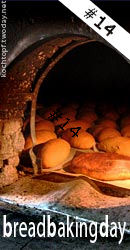
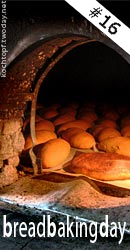
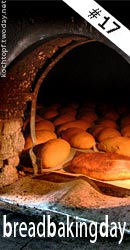






























































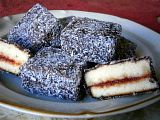






.jpg)











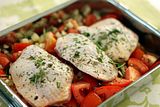

.jpg)





































